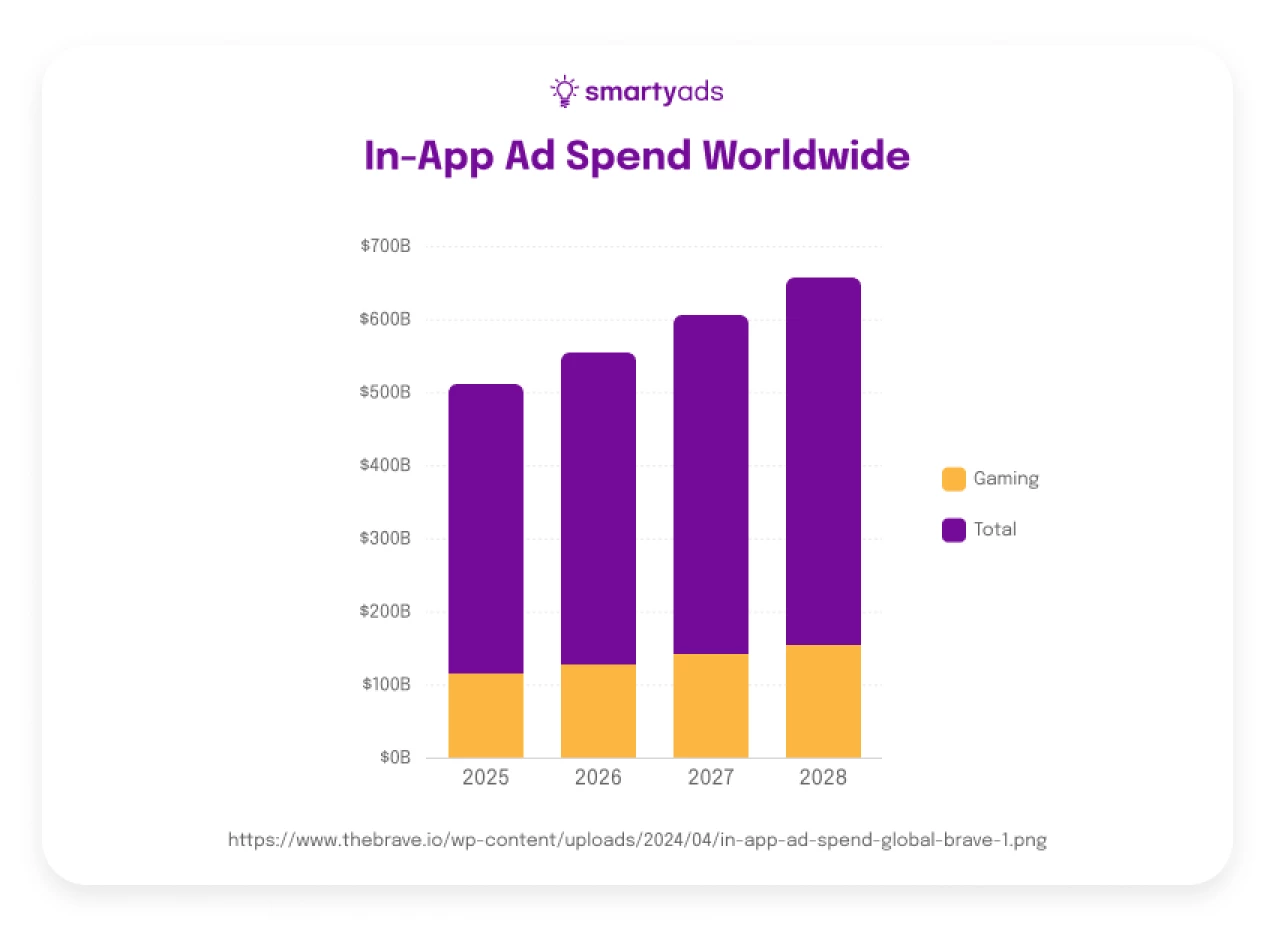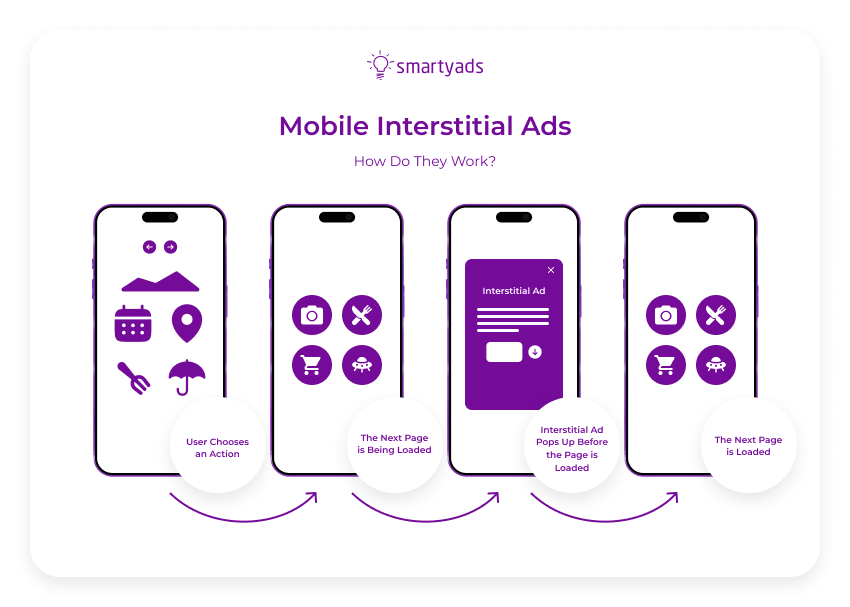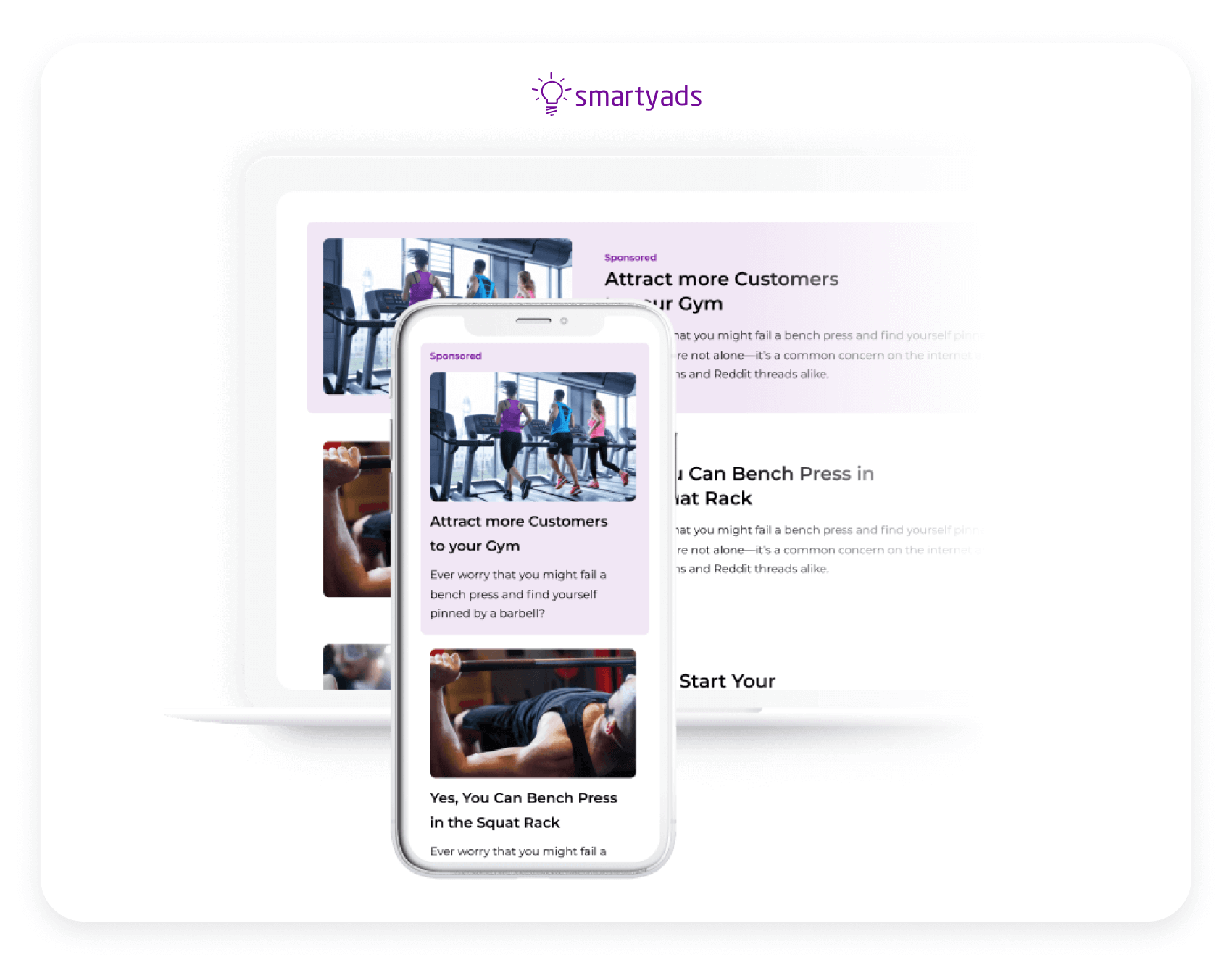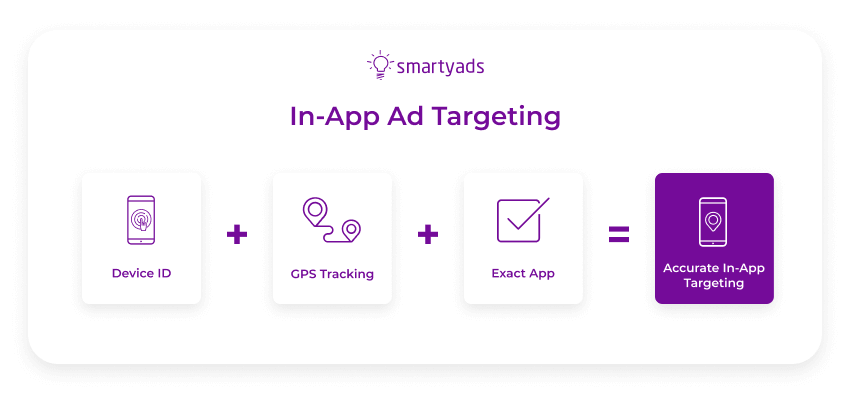What emerging mobile app trends and mobile ad formats will become popular in 2025? GDPR novelties, new safety measures, and other transformations are discussed in our detailed guide to in-app advertising.
Before moving on to trends, let's figure out the peculiarities of mobile ads, their types, and their formats.

What is mobile app advertising?
Mobile app ads, or in-app advertising, are paid ads broadcast to users when they interact with mobile apps. This format enables app owners to take advantage of an ad exchange by selling space to advertisers, who, in turn, make a profit out of each mobile display ad impression. Advertisers buy inventory from publishers through multiple ad exchanges powered by demand and supply mechanisms to provide good visibility and reach relevant audience segments.
The surge in popularity of in-app advertising started during the COVID-19 outbreak, when the time spent on mobile devices playing games and consuming various types of content grew drastically. Even after lifting restrictions, daily time spent on mobile phones has risen and is expected to reach around 5 hours by 2026.
Global ad spending in the in-app advertising market is reaching $390.04 billion by 2025. The industry is anticipated to grow at a compound annual growth rate (CAGR) of 7.88% from 2025 to 2030, reaching an estimated market value of $569.95 billion by 2030.
Meanwhile, in-app ad spend in gaming is also growing along with total ad spend. According to predictions, it will soar to 600B by the end of 2028.

That is why the popularity of in-app advertising is beyond doubt, as in-app ads offer lucrative monetization opportunities for all stakeholders. Once we've screened the global situation with mobile ads, it's time to take a deeper look at the gist and differences between mobile app ads and those on the web.
How mobile web advertising differs from in-app advertising
Before airing mobile advertisements or app advertising campaigns, it is important to realize that this medium is specific since the environment itself is completely different from the web. While on the web, ads are served through browsers, and app ads appear only inside the apps. Thus, there are two distinguished mobile advertising environments: mobile web ads and in-app ads.
Let's delve into the specifics of each type.
Mobile web ads
As the name implies, ads displayed within the browser are related to mobile web advertisements. This type of mobile app advertising allows for experimenting with ad formats and considerably decreases the cost of cross-platform ad campaigns. The creatives used for mobile web are auto-resizable and responsive, so their sizes and resolutions adjust automatically to fit various ad formats displayed on mobile devices. Through this compatibility, users are more likely to receive an improved experience, and thus, such ads encourage users to interact with displayed ads.
In-app advertising
In-app ads are streamed while users interact with mobile apps. The mobile app ads are delivered through a mobile app advertising network and allow bridging between advertisers and developers, enabling stakeholders to leverage in-app advertising opportunities to achieve their monetization goals.
How do app developers and advertisers benefit from in-app advertising?
App developers sell their inventory to advertisers so they can display their ads to relevant audiences in a brand-safe environment. Advertisers choose the best-fit mobile app monetization models to monetize active app users, paying per click, action, install, and other options.
Through in-app advertising, advertisers can achieve multiple marketing purposes:
- improve brand awareness;
- grow conversions;
- boost user engagement;
- level up user retention.
As for app developers, they make a profit from mobile ads by serving in-app ads on their apps. To do that, app developers utilize a software development kit to link up their applications with an ad network. This allows app developers to show users various ad formats through which they can interact with a brand. So, developers can monetize their app inventory when users take some actions in response to the displayed ad.
Given the features of web mobile and in-app ads, the distinctions between them fall under four criteria: tracking, types of user data collected, blocking ads, and median usage. Take a look at the table below to reveal more details about how web ads stand apart from mobile app ads.
| Web/mobile web | Difference criteria | In-app |
| Cookies | Tracking | Device ID |
| Web footprints (website activity, shopping history, browsing history) | Types of user data collected | Device type, GPS data, gender, age, etc. |
| Browser-based ad blockers | Blocking ads | No ad blockers inside of the apps |
| Half an hour | Median usage | Three hours and eight minutes |
Tried and tested formats of mobile in-app advertising
As more and more advertisers and publishers embrace in-app formats as their main source of revenue, in-app advertisements gradually gain momentum. According to statistics, in-app purchases remain the best-performing segment of the in-app advertising market in terms of revenue generation. They make up a great part of the publisher's mobile income and don't harm the user experience. IAP, combined with the right mobile ad formats, can even complement the user experience and elevate the number of clicks, views, and interactions.
So what mobile in-app advertising formats are all the rage?
Video ads
People are getting massively addicted to the gadgets and apps they use on a daily basis. That means marketers and advertisers will have to shift their gaze to mobile apps that people use most of the time.
By 2025, the mobile in-app ad spend is expected to reach nearly $399.6 billion, with video ad formats being the greatest contributors as they bring in over 30% of the revenue share. In fact, mobile video ads show five times higher effectiveness and stronger ad revenue-bringing properties than already exhausted banner ads.
While Facebook's ad revenue mostly consists of video ads, experts point out that large companies are willing to use mobile video advertisements to promote premium content. This happens because video ads require more resources and design efforts. Yet, video ads remain the leaders of mobile app ads because they deliver the best engagement rates.
Interstitial, both playable and rewarded, ads are the most popular and promising formats of video in-app advertising due to their interactivity and attention-grabbing nature.

Interstitial ads
Interstitials ads are full-screen videos shown between game levels, at pauses, or when switching within the app. Due to their viewability, interstitial ads encourage users to keep engaging with an app, avoiding banner blindness, and are thus more likely to generate high impression and click-through rates.

Playable ads
Playable ads provide a game-like experience that lasts from 15 seconds to a minute. These interactive video ads encourage users to experience a true-to-life mini-game with full involvement and interaction. As a rule, playable video ads appear inside gaming apps, hitting the target audience, which often matches. Besides, with this mobile in-app ad, users can safely sample the products inside the gaming apps without going the extra mile for authorization.

Rewarded video ads
Rewarded video ads are shown to users in exchange for some prizes like extra coins, access to exclusive content or features, an extended free trial, and other goodies. The majority of users like this ad format because of its interactivity and the chance to get a bonus.
Due to the positive experience rewarded video ads bring to users, advertisers will continue leveraging the potential of this ad format. It is worth mentioning that effective cost-per-mille (eCPM) through different markets is soaring between $19.40 in the United States and $9.29 in the United Kingdom.
Native ads
Native advertising on apps is very beneficial. Users admit to being ready to share the content of the native ad format with others when the average in-app ad can be taken as annoying and intrusive. That happens because native ads blend with the page's content so it can exist everywhere: social media feeds, search listings, content recommendations, etc.

During the last couple of years, however, the users learned how to distinguish native ads from the rest of the content. It hasn't much affected the effectiveness of this mobile ad format. Still, native ads should also deliver valuable content and have ad marks. Otherwise, they may increase irritation when the user finds out that the material is commercial.
Display ads
Display in-app advertising that encapsulates text, banner ads, audio, and video brings around 20% of the total revenues. Within a variety of display units, rich media ad formats stand out because the CTR of these mobile ads outperforms the CTR of banner ads by 250% (due to the abundance of elements).
The global pandemic encouraged people to spend more time on mobile web and in-app. Accordingly, global App Store and Google Play ad spending increased and was expected to grow over the next couple of years.
Even after lockdown restrictions were set aside, this tendency has only risen. Mobile app spending is reported to reach $399.6 billion by 2025.
After dotting the i's and crossing the t's by making mobile app ads clear and understandable, it's time to regard trends in mobile advertising.
In-app targeting enabled with first-party data
First-party data is information retrieved directly from an app user that covers user behavior, preferences, geography, interaction with a mobile app, purchase history, ad impressions, or any other information potentially used to deliver a personalized experience. Yet, it's important to understand that app developers ensure data security for their users, as sensitive information is usually encrypted and can't be used per se.
Advertisers apply first-party data to deliver an advanced in-app advertising experience for consumers within legal frameworks. Mobile advertising offers a variety of opportunities for those brands that strive to target based on first-party data, which becomes available when the user opts in for data collection. If the user opts in for data collection and personalized advertising, advertisers are granted the right to serve targeted ads on their device.
Geo-targeting
As of now, geo-targeting mobile technologies are the top trend in the in-app advertising field as they enable agencies and brands to reach out to mobile users with relevant ads according to their current geolocation data, making ads more granular. App publishers, meanwhile, provide app inventory for advertisers interested in this region to obtain payment per click on the ad placed inside their app, be it a view or action based on the payment model.

How to track opted-in mobile users
Each mobile device has an ID, which makes it possible to identify a particular user for ad targeting. It is very convenient since such IDs are active for 21 months, which is way more than cookies can be stored for up to 90 days (usually 24 hours).
Since IDFA measurement has been restricted, advertisers make use of SkadNetwork, Apple's API-based platform for attribution and ad measurement. It counts how many users convert and install the app. Such a method of measurement is privacy-friendly since it separates the actual app install from the impression.
| Cookies (on mobile web) | Mobile IDs |
| Erased within 24 hours | Active for 21 months |
| Not opt-in | Privacy-friendly |
| Dependent on browsers | Tied to user devices |
Measuring the viewability of app advertising
Advertisers choose different measures to track viewability on mobile web browsers and within apps. To run it correctly, it's important to regularly monitor pixels and time.
Pixels for mobile web advertising
Advertisers analyze whether users scroll down the page enough actually to see the ad. In order to be regarded as 'viewable', the ad should be visible at least 50% of the time.
Time within mobile apps
Mobile ads should linger in the user's viewable area for at least one second to qualify as delivered. This method requires the use of software development kits (SDKs) installed by the app owners.
Mobile app advertising safety issues
Fraud costs advertisers millions of dollars, even though ad networks are implementing more and more anti-fraud measures.
One of the four Ad Security Predictions for 2025 suggests an expected increase in the occurrence of artificial intelligence (AI)-driven threats in the realm of digital advertising. As AI continues to advance in sophistication, bad actors are adjusting their tactics accordingly.
Therefore, stakeholders prioritize safety as an investment in sustainable business development. According to a recent report, 67% of digital advertisers level up their brands with security measures in mobile and app marketing to deliver a positive impression of their brand to users.
Advertisers, ad networks, app publishers, and ad exchanges seek bespoke approaches to privacy and work together more closely to solve this problem, increasing transparency with GDPR and shifting to white-label blockchain fraud-resistant ad solutions.
In-app advertising and new GDPR landscape
GDPR affects mobile in-app advertising in the same way it affects the entire digital advertising medium. Some marketers have to find new ways to target audiences without collecting the personal data of EU residents; others shift to blockchain ad platforms to eliminate third-party intermediaries.
Blockchain ad networks and other solutions can provide an answer to problems associated with automated in-app advertising. By bringing a full audit on every transaction or operation, blockchain ensures that every party gets access to the data and identifies every chain participant.
Theoretically, the result of GDPR standards implementation in the in-app advertising market is a transparent advertising space that is equally beneficial to all participants (including end-users, sites, and apps that will have to be adapted with opt-ins and tools for personal data management).
So, how do you advertise on mobile and create a flawless app advertising campaign on demand-side platforms (DSP)?
How to make in-app advertising work impeccably
In fact, it can be as easy as 123. Consider the following steps to get the best result:
Choose a format for mobile apps
Classic mobile banners suit app advertising campaigns best if you strive to find the most affordable format for app advertising. Go for video ads if you have plenty of information to deliver. Select natives for an unintrusive experience and interactive playable ads for memorability and engagement.
Select suitable sizes
Large-resolution, full-screen ads may be flattering to the eyes and more memorable for your in-app advertising campaign. However, if you want a better reach, select medium and smaller ad units; there are a large number of smaller ad slots available on the in-app market, so with such sizes, you will most likely have a better reach.
Select deal type
In-app advertising placement can be organized with two main programmatic deal types: programmatic direct (no RTB auctions involved) and through RTB (real-time bidding). Plus, inventory can be purchased in open auctions and PMPs (private auction types).
How to advertise on apps with DSP
Mobile in-app advertising works out extremely well, a little less well, or not well at all. Everything will depend on additional circumstances such as targeting users correctly for your platform, ad format and size, ad placement, access to the right ad network, and a bunch of other important factors.
In order to make the most of mobile app ads, keep an eye on the following things:
Geo
App advertising units should be delivered according to the characteristics of the audience. Choose a language and country to keep your in-app ads relevant.
Spend
If you launch an app advertising campaign on DSP, it will be a good practice to pre-define how much money you are willing to spend per day on the advertising campaign (daily spend).
Frequency
Frequency is how often one ad unit will hit the viewer's gaze. Limiting the number of views and daily spending can successfully prevent overspending and ad fatigue.
To sum up
If you plan to apply app advertising, think about ad format and placement that can make your message noticeable (yet not annoying), learn who your user is, and choose a good demand-side platform or ad network that will connect you to the pool of global app publishers.
SmartyAds demand-side platform is a forward-thinking GDPR and privacy-friendly technology where advertisers can serve the most innovative app ad formats and perform robust advertisement optimization in real time. Targeting, budget, frequency, and the rest of the individual settings are available in a single, convenient interface through which you can manage your advertising campaign and optimize the flow in real time.
Need to launch really effective mobile app advertisements? Sign up at SmartyAds DSP!

![In-App Advertising: the Complete Guide [Updated 2025]](/storage/uploads/2020/september/in-app-advertising-trends.png)
.webp)


